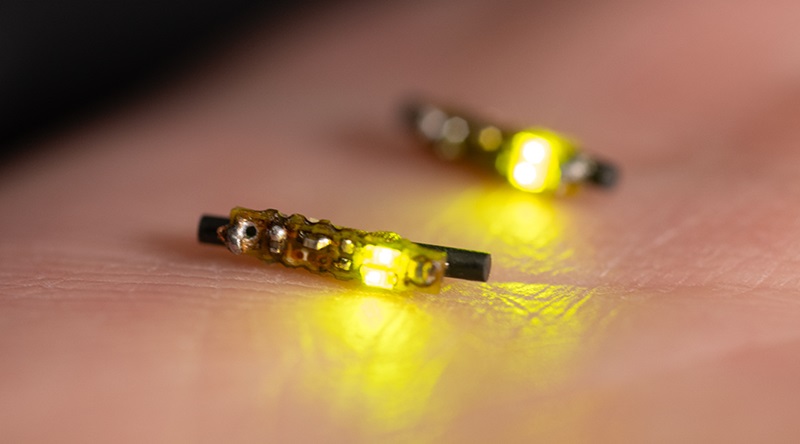Wireless Implantable LED Device Treats Deep-Seated Cancers Using Light
|
By HospiMedica International staff writers Posted on 10 Jul 2024 |

Certain types of light, when used in conjunction with a light-activated drug, have been shown to be an effective, minimally invasive treatment for cancers situated on or just beneath the skin. However, cancers that are deep-seated and shielded by layers of tissue, blood, and bone have historically been unreachable by light-based treatments. To extend the therapeutic benefits of light to these more inaccessible cancers, a team of engineers and scientists has developed a wireless, implantable LED device. This innovative device, when used alongside a light-sensitive dye, not only kills cancer cells but also stimulates the immune system’s cancer-targeting response.
Some colors of light have been found to penetrate tissue deeper than others. Green light, which does not penetrate very deeply, is particularly effective at eliciting a strong anti-cancer response. However, before the light can effectively destroy cancer cells, the cells must be treated with a dye that contains light-absorbing molecules. Engineers and scientists at the University of Notre Dame (Notre Dame, IN, USA) have created a device that activates this dye, converting the light into energy that converts the cells’ own oxygen into a toxic agent, thereby turning the cancer cells against themselves. While other treatments also use the cells' oxygen in a similar manner, this device uniquely induces a type of cell death that is especially beneficial.
In their research published in Photodiagnosis and Photodynamic Therapy, the team observed that the treated cells exhibited swelling, indicative of a type of cell death known as pyroptosis. This form of cell death is particularly effective at activating the immune response. The device, small enough to be the size of a grain of rice, can be injected directly into a tumor and activated remotely via an external antenna. The aim is to induce a small amount of pyroptotic cell death, which in turn triggers the immune system to begin attacking the cancer. The device is designed not just to administer treatment but also to monitor the tumor’s response, allowing for adjustments in signal strength and timing as necessary. Future experiments will involve using the device in mice to determine if the immune response triggered in one tumor can encourage the immune system to recognize and attack another cancerous tumor independently.
Latest Critical Care News
- Novel Cannula Delivery System Enables Targeted Delivery of Imaging Agents and Drugs
- Ingestible Smart Capsule for Chemical Sensing in the Gut Moves Closer to Market
- Novel Intrabronchial Method Delivers Cell Therapies in Critically Ill Patients on External Lung Support
- Generative AI Technology Detects Heart Disease Earlier Than Conventional Methods
- Wearable Technology Predicts Cardiovascular Risk by Continuously Monitoring Heart Rate Recovery
- Wearable Health Monitoring Device Measures Gases Emitted from and Absorbed by Skin
- Groundbreaking Technology Rapidly Detects Airborne Influenza Viruses
- Handheld Device Could Transform Heart Disease Screening
- Flexible Semi-Autonomous Robot Could Deliver Medicine Inside Body

- Neurorestorative Treatment Strategies Hold Promise for Most Severe Forms of Epilepsy
- Gene Discovery Could Help Grow New Heart Arteries
- Study Discovers Invisible Transmission of Common Hospital-Associated Infection
- Non-Invasive Neuro-Ophthalmology Techniques Could Detect Brain Tumors Earlier
- Mass Manufactured Nanoparticles to Deliver Cancer Drugs Directly to Tumors
- World’s Smallest Pacemaker Fits Inside Syringe Tip

- AI-Powered, Internet-Connected Medical Devices to Revolutionize Healthcare, Finds Study
Channels
Surgical Techniques
view channel
Pioneering Sutureless Coronary Bypass Technology to Eliminate Open-Chest Procedures
In patients with coronary artery disease, certain blood vessels may be narrowed or blocked, requiring a stent or a bypass (also known as diversion) to restore blood flow to the heart. Bypass surgeries... Read more
Intravascular Imaging for Guiding Stent Implantation Ensures Safer Stenting Procedures
Patients diagnosed with coronary artery disease, which is caused by plaque accumulation within the arteries leading to chest pain, shortness of breath, and potential heart attacks, frequently undergo percutaneous... Read more
World's First AI Surgical Guidance Platform Allows Surgeons to Measure Success in Real-Time
Surgeons have always faced challenges in measuring their progress toward surgical goals during procedures. Traditionally, obtaining measurements required stepping out of the sterile environment to perform... Read morePatient Care
view channel
Portable Biosensor Platform to Reduce Hospital-Acquired Infections
Approximately 4 million patients in the European Union acquire healthcare-associated infections (HAIs) or nosocomial infections each year, with around 37,000 deaths directly resulting from these infections,... Read moreFirst-Of-Its-Kind Portable Germicidal Light Technology Disinfects High-Touch Clinical Surfaces in Seconds
Reducing healthcare-acquired infections (HAIs) remains a pressing issue within global healthcare systems. In the United States alone, 1.7 million patients contract HAIs annually, leading to approximately... Read more
Surgical Capacity Optimization Solution Helps Hospitals Boost OR Utilization
An innovative solution has the capability to transform surgical capacity utilization by targeting the root cause of surgical block time inefficiencies. Fujitsu Limited’s (Tokyo, Japan) Surgical Capacity... Read more
Game-Changing Innovation in Surgical Instrument Sterilization Significantly Improves OR Throughput
A groundbreaking innovation enables hospitals to significantly improve instrument processing time and throughput in operating rooms (ORs) and sterile processing departments. Turbett Surgical, Inc.... Read moreHealth IT
view channel
Printable Molecule-Selective Nanoparticles Enable Mass Production of Wearable Biosensors
The future of medicine is likely to focus on the personalization of healthcare—understanding exactly what an individual requires and delivering the appropriate combination of nutrients, metabolites, and... Read more
Smartwatches Could Detect Congestive Heart Failure
Diagnosing congestive heart failure (CHF) typically requires expensive and time-consuming imaging techniques like echocardiography, also known as cardiac ultrasound. Previously, detecting CHF by analyzing... Read moreBusiness
view channel
Expanded Collaboration to Transform OR Technology Through AI and Automation
The expansion of an existing collaboration between three leading companies aims to develop artificial intelligence (AI)-driven solutions for smart operating rooms with sophisticated monitoring and automation.... Read more
















